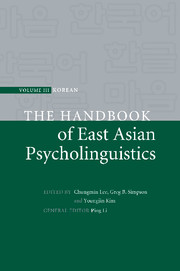Book contents
- Frontmatter
- Contents
- List of figures
- List of tables
- List of contributors
- Preface
- Introduction: Advances in Korean psycholinguistics
- Part I Language acquisition
- Part II Language processing
- 28 Visual processing of Hangul, the Korean script
- 29 English vowel spaces produced and perceived by Americans and Koreans
- 30 Morphological representation and processing of Sino-Korean words
- 31 The role of phonology in word recognition of Korean Hangul and Hanja
- 32 Lexical and sublexical processes in Korean word recognition
- 33 Prosody in sentence processing
- 34 Korean sentence processing
- 35 Sentence processing and memory representation in Korean
- 36 Understanding complex sentences: memory constraints and informational structure
- 37 ERP studies of Korean language processing: word-order effects
- 38 Inferences during discourse comprehension in Korean
- 39 Morpho-syntactic processing in Korean aphasics
- 40 Morpho-syntactic processing of Korean-speaking adults with Broca's aphasia
- 41 Comprehension deficits in Korean agrammatic aphasia
- 42 Developmental reading disorders in Korean
- 43 Individual differences in Korean language processing: context-dependent processing of skilled readers in word ambiguity resolution
- 44 A computational model of lexical and morphological processing in Korean
- References
- Name index
- Subject index
39 - Morpho-syntactic processing in Korean aphasics
from Part II - Language processing
Published online by Cambridge University Press: 05 June 2012
- Frontmatter
- Contents
- List of figures
- List of tables
- List of contributors
- Preface
- Introduction: Advances in Korean psycholinguistics
- Part I Language acquisition
- Part II Language processing
- 28 Visual processing of Hangul, the Korean script
- 29 English vowel spaces produced and perceived by Americans and Koreans
- 30 Morphological representation and processing of Sino-Korean words
- 31 The role of phonology in word recognition of Korean Hangul and Hanja
- 32 Lexical and sublexical processes in Korean word recognition
- 33 Prosody in sentence processing
- 34 Korean sentence processing
- 35 Sentence processing and memory representation in Korean
- 36 Understanding complex sentences: memory constraints and informational structure
- 37 ERP studies of Korean language processing: word-order effects
- 38 Inferences during discourse comprehension in Korean
- 39 Morpho-syntactic processing in Korean aphasics
- 40 Morpho-syntactic processing of Korean-speaking adults with Broca's aphasia
- 41 Comprehension deficits in Korean agrammatic aphasia
- 42 Developmental reading disorders in Korean
- 43 Individual differences in Korean language processing: context-dependent processing of skilled readers in word ambiguity resolution
- 44 A computational model of lexical and morphological processing in Korean
- References
- Name index
- Subject index
Summary
Abstract
Korean is highly productive as an agglutinative language which has rich verbal and nominal inflections. This chapter, which deals with various aspects of Korean morphology, such as nominal cases, prefinal endings, and final endings, will shed great light on the complex morpho-syntactic structure of Korean. It will review some research in morpho-syntactic processing by Korean aphasic patients. We will present some studies of morpho-syntactic processing such as case marker processing, morphemic ambiguity resolution, agrammatism, and questions relating to pronouns. Understanding the proposed experiments of aphasic data will give us insights concerning the determination of the ‘cognitive architecture’ of language.
Introduction
Neurolinguistics, as the study of the neurobiology of language, is concerned with the brain mechanism which permits us to understand and to produce language. Studying speakers whose language is impaired, along with their modes of acquisition and use of language, provides a window through which the structure and processing of language may be considered. Aphasic research has been an important area of neurolinguistics and is primarily devoted to an attempt to understand the relationship between the brain and language. The fact that damage to some parts of the brain results in language loss, but damage to other parts of the brain leaves language more or less intact, supports the view of the structured brain with separate faculties.
Current studies on aphasic research were mostly conducted with Indo-European languages. Findings obtained by studies on these languages do not confirm whether the phenomena or results are universal or language-specific ones.
- Type
- Chapter
- Information
- The Handbook of East Asian Psycholinguistics , pp. 484 - 493Publisher: Cambridge University PressPrint publication year: 2009



